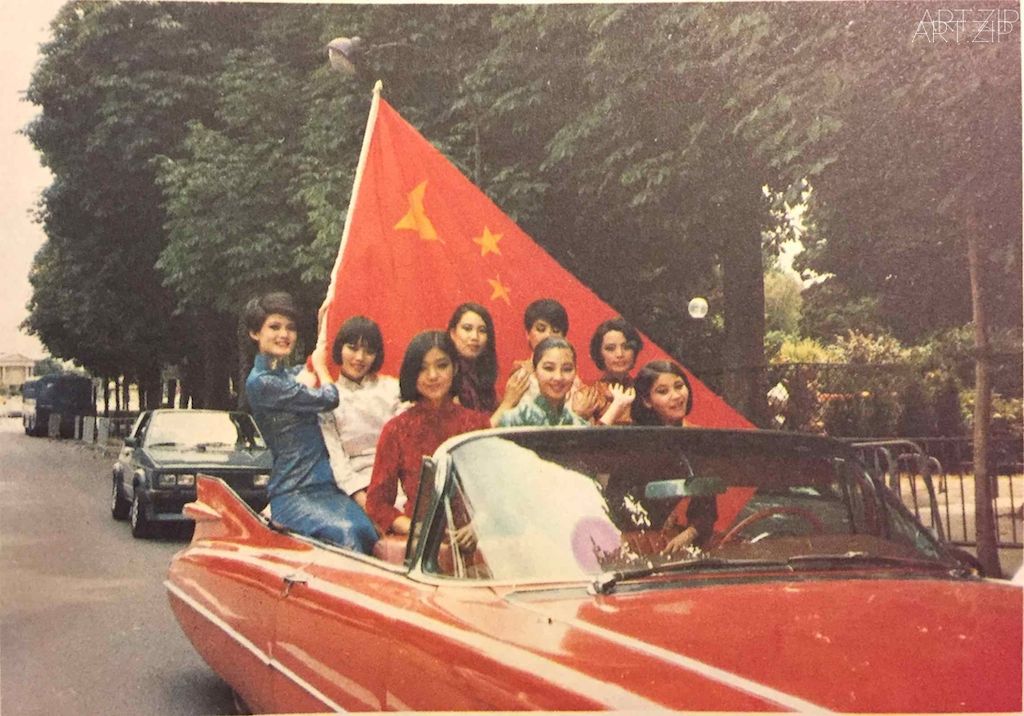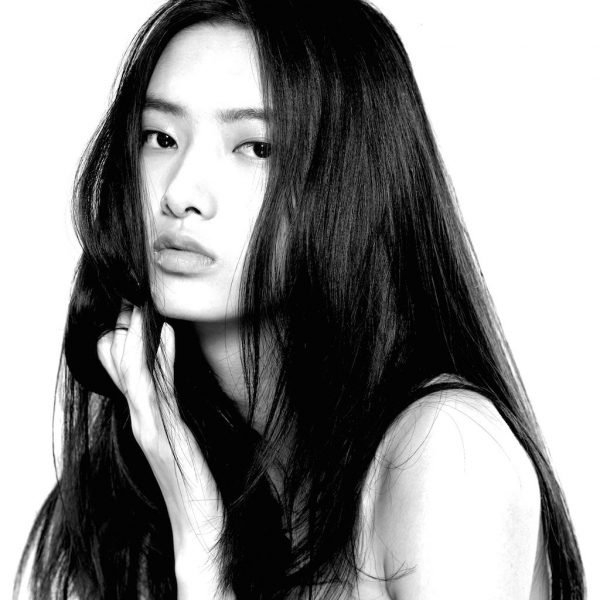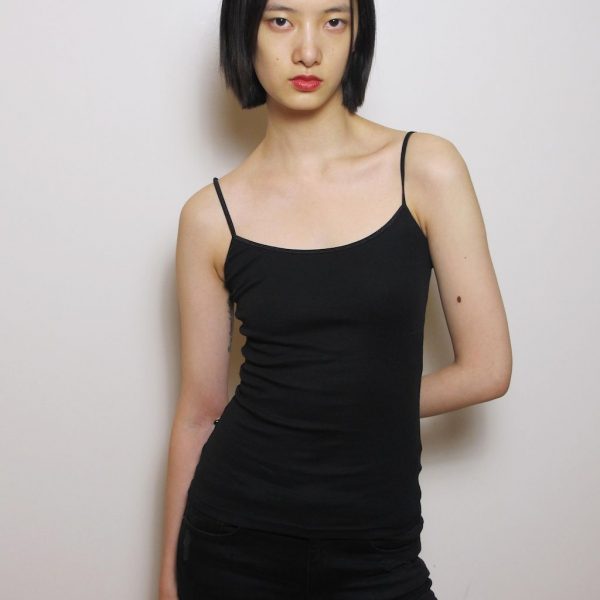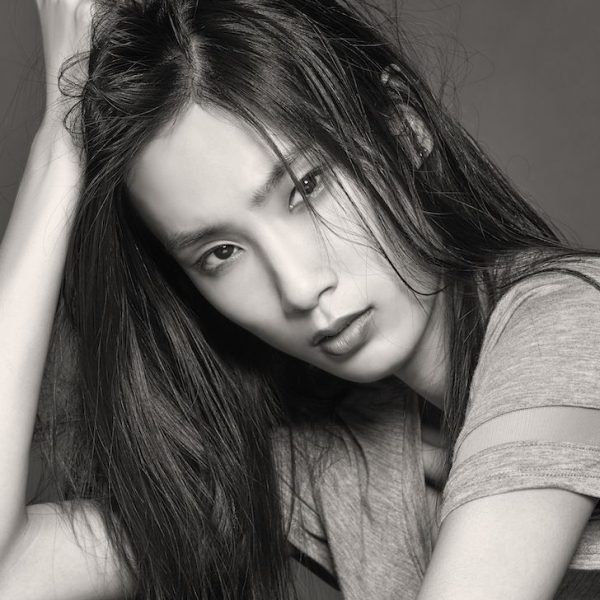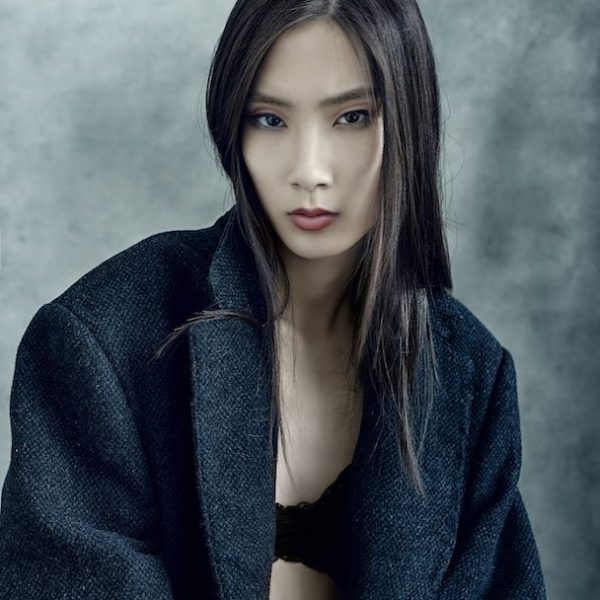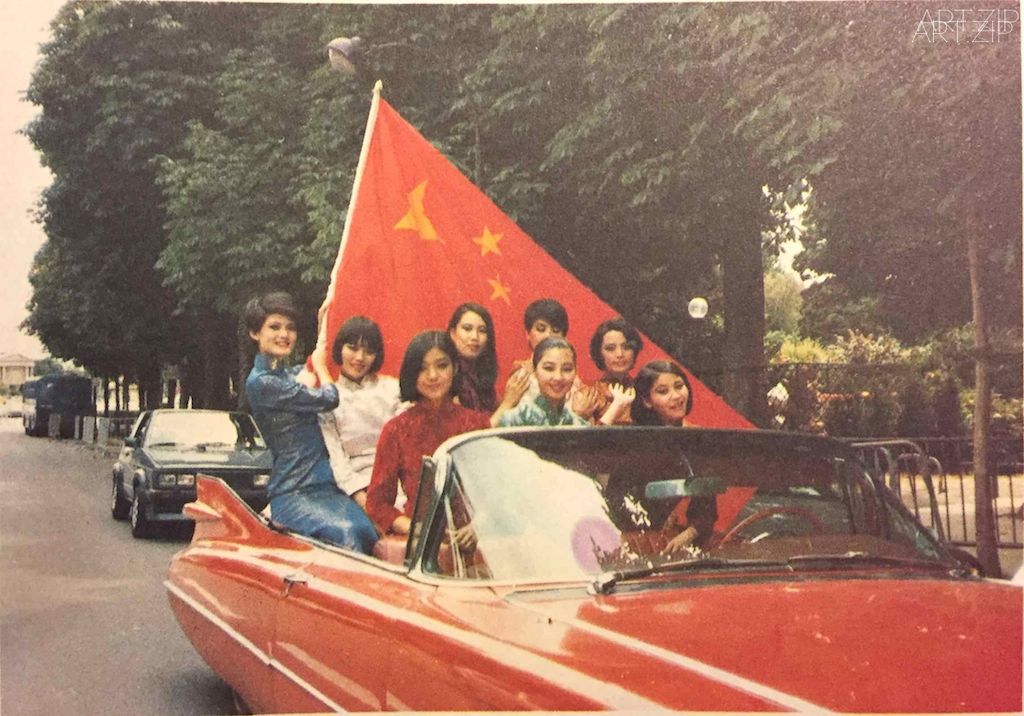
30 years since the first international appearance of Chinese models
text by Jin Li Lim
.
.
22 July 2015 will mark the 30th anniversary of the first time (ever) that fashion models from the People’s Republic of China travelled overseas to walk in a show for a Western designer. Three decades ago, the designer Pierre Cardin brought nine models to Paris to walk in his 1985 couture show, and in so doing, announced the arrival of China’s (still) nascent fashion industry onto the international stage.
Today of course, fast-forward a generation or so from 1985, Chinese models (both men and women) have become a regular sight in global fashion, paralleling the rise also of the inordinate importance of the Chinese fashion market to the fashion industry. Chinese supermodels adorn pages of glossy, authoritative and prestigious publications, walk on the hallowed runways of Paris, London, Milan and New York, and exert significant influence in all aspects of marketing. At the same time, China’s contribution to fashion has evolved beyond mere supply economics as it exerts a greater and greater pre-eminence in the strategic planning of fashion brands and retail conglomerates. Equally, recent years have seen also the emergence of distinctly Chinese designers making their own mark on the fashion world. Clearly, much has changed in the last thirty years.
That Chinese fashion (writ large) today is near unrecognisable from its 1985 iteration has as much to do with economic changes and circumstances as it does with the story of Pierre Cardin’s nine Chinese models. It was Pierre Cardin, after all, who was first into China in 1979 as the latent giant of the Far East roused itself into gradual economic opening-up. Cardin saw immense potential for fashion in China, and he was determined to be first in. March 1979 therefore saw the first ever fashion show by a Western designer in the PRC. This was quickly followed by more Cardin shows—including one in the heart of Zhongnanhai in 1983, and most memorably, one in front of a crowd of 15000 in the Workers’ Stadium in Beijing. At the same time, Cardin had also, since 1979, pushed for the employment of local Chinese models, and the first Chinese ‘modelling team’ (as they were known) was formed in 1980.
Modelling, as a profession, is probably not an easy occupation in the best of circumstances. It was even worse in the 1980s in China as not only did models have to contend with the physical demands of their job, but also immensely negative perceptions from large segments of society who considered such work immoral, if not evidence of Western corruption. Chinese society, only recently out of the isolation of the Cultural Revolution and grappling to deal with the intense socio-political changes that accompanied economic reform, was vey often unfriendly to these young girls who led the way for Chinese modelling as a profession.
Thankfully for posterity, the first Chinese models persisted and their legacy has played a profound role in what has become Chinese fashion. As the first representatives of Chinese fashion (and culture, as Cardin himself believed) to step onto an international stage, the nine Chinese models in Paris in 1985 were not merely embarking on an adventure of a lifetime, but were also announcing China’s re-entry into global cultural consciousness. Long before Olympic Games Beijing, supernormal economic growth, and even Panda Diplomacy, it was nine young Chinese girls who were (literally) carrying the Chinese flag overseas. They were the literal faces of New China, and their achievement is worth remembering. Fashion may have forgotten this moment, but in speaking to two stellar representatives of the latest generation of Chinese models, it seems clear that the legacy of Cardin and the nine young Chinese girls of 1985 is well and truly alive.
—
Cici Xiang (項偞婧)— 20 years old, exploded onto the international fashion stage in September 2013, walking in shows in New York, London, Milan and Paris in her debut runway season. Today, in as much as she can count (among other things), a Vogue China cover, and an & Other Stories campaign to her list of achievements, she is also—most remarkably—reading for a degree in Art History in London.
Dylan Xue (薛冬琪)— 21 years old, was anointed by Style.com as one of the ‘Top 10 new models of Spring 2015’ and has not turned back since. Dylan has gone on to claim legions of admirers, shooting campaigns for Coach and Alexander Wang, and adorning editorials in major publications.
.
- Cici Xiang
- Cici Xiang
- Dylan Xue
- Dylan Xue
.
[Translated from the original Chinese interview]
Jin: Were you aware of the story of Pierre Cardin and the ‘1985 generation’ of Chinese models when you were growing up, or is it something that has been forgotten by most people?
Cici: I had heard something about it, but I didn’t really understand it. When I was growing up, the older generation of my family had little knowledge of the fashion world; I only started to learn more about fashion when I was in junior high when I began to read fashion magazines. Perhaps the majority of younger people have similar stories.
Dylan: I had heard of it actually—a teacher had mentioned it when I was still in school.
J: How much of an influence would you say previous generations of Chinese models have had on you, not only as you were growing up, but also when you were first starting your careers?
C: There is absolutely no doubt about it—they are my role models. They were the ones who told me what modelling was all about, what I needed to do, and what it could offer.
D: I feel that there definitely has been an influence. The fact is that it is only because of the international success of previous generations of Chinese models that new talents from China can have the opportunity for greater recognition in international fashion.
J: When the ‘1985 generation’ was first coming up, it was not easy to be a model in China. Some people thought it was scandalous, or not proper for girls to be using their bodies in such a way. Did you encounter any resistance when you first decided to be a model? Is it easier to be a model in China today? What has changed?
C: Yes—I mean, even though China is increasingly more open, the models that came before me were all bound by traditional perspectives that often saw overexposed or even so-called scantily clad women as indecent. When I first wanted to pursue this career, my father thought I should prioritise my studies first. Today, many people still have certain misconceptions about models, but I also have to say that over time, people have become more able to see the bigger picture, more open-minded, and there certainly more parents who are willing to support their child if she has what it takes to become a model.
D: To be honest, I never did experience such criticisms. My family was very supportive of me becoming a model. Initially, I wanted to be a model simply because it offered me a chance to explore myself. I had done some modelling while still in school in China, but I certainly did not expect to be recognised so soon after arriving in New York. Society in China is more open-minded than before, people are not the same—I don’t think they view models through the same tinted glasses. Instead, I only have the greatest of respect for my fellow models; everyone has gotten to where they are because they have been willing to work hard to fulfil their dreams even though they know that this industry can be a particularly difficult one to succeed in.
J: 20 years from now—perhaps at the 50th anniversary of the ‘1985 Generation—when a later generation of Chinese models looks back at 2015, what do you hope they will say of your generation?
C: I hope they will see us in a similar way to how we view the generations of Chinese models who have preceded us—as positive examples to learn from. I hope also that they will climb even greater heights and expand the influence of Chinese fashion.
D: I think the ‘2015 generation’ will have become another legendary generation by that time—perhaps some magazine will interview these models and ask them to reflect on us.
J: Both of you have achieved so much in a relatively short period of time—what is next in line for you?
C: I hope to keep doing the things that I love.
D: This past year has given me the confidence and inspiration to persevere in the modelling industry. I definitely will continue to work hard and strive to reach the heights of a supermodel one day.
[2人]
J:在成長的過程中,你可曾了解皮爾卡丹[Pierre Cardin]和“1985一代”中國模特的故事?或許這故事已經被大多數人遺忘了?
薛冬琪(Dylan Xue):我之前聽說過,我在上學的時候老師有講過。
項偞婧(Cici Xiang):不太了解但有所聽聞,在我的成長家庭中長輩少聞時尚界,我是自己從初中開始看時尚雜誌才一點點了解的。也許現在大多數年輕人和我一樣。
J:對你而言,之前的幾代中國模特是否有對你自己的成長以及模特生涯的最初階段與發展有積極的影響嗎?
D:我覺得是有的,正是因為前幾代的中國模特在國際上發展的很成功,現在的中國新人才能被國際時尚界重視。
C:毫無疑問,他們是我的榜樣。是他們告訴我模特是一個什麽樣的職業,需要做什麽,能帶來什麽。
J:在1985 年的中國,要成為一名模特並不容易。當時很多人認為女性利用自己的身體是傷風敗俗,不合體統的一種表現。當你決定當模特的時候,你有受過同樣的壓力和批評嗎?以你的看法,如今模特這個職業會不會比較容易受到社會認可?和1985 年相比,現在發生了什麽變化?
D:我沒有受過這種批評,我的家人很支持我當模特的,起初想做模特純粹是想改變氣質,在國內上學的時候也做過一段時間的模特,沒想到來到紐約之後,迅速的被認可,也是讓我很驚喜。
現在的社會更加開放,人們不再像以前一樣,用有色眼鏡來看待模特行業。反而我覺得我很尊敬這個行業的模特,因為大家都是為了自己夢想努力的人,即使知道這個行業很難。
C:是的,中國在日漸開放起來,但直至我的上一輩都不免受到傳統思想的束縛,認為女性過度曝光或衣著裸露是不雅的事情,當初我想參與這個行業時,我父親就認為我應當以學業為主。如今依舊有很多人誤解模特這個行業,但不得不說隨時間推移,人們眼光越來越遠,思想越來越開放,也有越來越多的家長支持有條件的孩子去嘗試做模特。
J:想象一下20 年以後,你希望那些後輩新生力量將會如何看待你們的時代“2015 一代”?
D:我覺得我們2015一代也會成為傳奇的一代,可能之後也會有雜誌采訪他們,問她們對我們的看法。
C:我希望他們看我們就如同現在我們看我們之前幾代模特一樣,是一個好的學習對象,也希望他們那時具有更大的中國影響力。
J:二位在如此短的時間內就已在時尚圈裏獲得令人欽佩的成就;你們下一步是如何規劃的呢?
D:這一年給我在模特行業繼續做下去有了充分的信心,我是肯定會繼續努力,爭取有一天也可以成為超模。
C:一直做自己喜歡做的事情。
.
[To Cici]
J: Cici, as someone who is well versed in Art History, how would you describe current developments in the Chinese fashion industry? Is there a distinctive Chinese identity in fashion these days—or is fashion too international for localised identity?
C: Actually, contemporary Chinese fashion and the new generation of the Chinese art scene are slowly becoming intertwined; people from the fashion world are becoming involved in art, and artists are also appearing in fashion magazines. China has a rich and profoundly deep cultural heritage—perhaps on a scale that is not replicated elsewhere—and so Chinese fashion certainly has its own distinctive elements. But at the same time, because fashion is so globalised, designers increasingly borrow and draw on myriad cultural ideas from across the world, so fashion is not really something you can demarcate with national boundaries.
J: In 1985, when Pierre Cardin was trying to seek approval from the Chinese government to bring the Chinese models to Paris, he told a Minister that: ‘they [the models] are going to France not only to show how beautiful Chinese girls are, but to also display Chinese culture.’ Do you think this is true? Do Chinese models have a responsibility beyond being just a model, but as cultural ambassadors for China as well?
C: I very much agree. I think a good model in the fashion world has a sort of dual, if not ‘win-win,’ role—on the one hand for herself, but also on the other hand, for her country. When a model’s individual career reaches a certain level of success in the industry, that success brings with it legitimate influence within that industry. Symbiotically, this also causes the fashion world to pay more attention to the country where the model has come from, and to pay more attention also to what is distinctive, unique and resonant about that country. Just look at the rise of contemporary Chinese fashion, and not forgetting this year’s Met Gala theme [‘China: Through the Looking Glass’]—these developments owe much to the Chinese who have carved out niches for themselves in fashion, and certainly to Chinese models as well.
J: In the view of an Art Historian, are there other moments, personalities or events in the larger story of Chinese fashion that should be commemorated?
C: To be fair, and on a personal note, my interests tend towards studying pure art, so the only qualification I have to comment on fashion is as an amateur. But from an amateur’s point of view, another historical event worthy of note would be Du Juan’s invitation to the Met Gala all those years ago—yet another first for Chinese models and fashion.
[Cici]
J:Cici,你是一個對藝術史頗有了解的人,基於此知識,你對如今中國時尚界的發展趨勢有什麽看法呢?你認為中國時裝有屬於自己的元素嗎,或者說你會不會覺得時尚已經是不分國界的了?
C:現在中國時尚圈和中國新生代藝術圈慢慢交織在一起,時尚人士涉及藝術,藝術家出現在時尚雜誌中。我認為中國有著深厚的文化底蘊,是別的國家不具有的,為此中國時尚必定有著屬於自己的元素;而如今時尚是個全球化的東西,設計師借鑒各種文化元素,這樣說來時尚又是不分國界的。
J:1985 年,皮爾卡丹申請中國政府批準,允許他帶領中國模特前往巴黎走秀。當時他曾說過:“她們法國之行不僅是展示中國女性的美麗,更為了傳播中國的文化。”你同意他的看法嗎?作為一名中國模特,在做好本職工作的同時是否還需要兼備文化傳播的義務?
C:非常同意。我認為一個好的模特會在時尚圈有著雙贏的作用,一為自己二為國家。當模特自己本身達到一定水平後他在整個時尚圈就有著自己的影響力,時尚圈就會放眼去看他背後的國家以及國家給予這個模特的不同尋常的東西。像如今中國時尚圈的影響力越來越大,今年Met Ball的主題就是中國風,這要感謝每一個從事時尚的中國人(中國模特)。
J:從藝術史學者的角度來看,中國時尚界是否還有其他一些更重要的時刻、事件或者人物應當記錄下來?
C:其實個人而言我偏向於對純藝術的學習,所以可謂時尚界的業余愛好者。以業余的角度而言,像多年前杜鵑作為第一位中國模特被邀去參加Met Ball這件事情就應當被記錄下來。
.
[To Dylan]
J: Dylan, in 1985, having Chinese models on a runway would have been seen as an unprecedented step by a Western designer. Today, Chinese models like yourself are a regular sight in the world’s fashion capitals, there are Chinese supermodels, Chinese models fronting campaigns (like you) and magazine covers; what do you think is the next frontier for Chinese models?
D: Perhaps it used to be the case that the fashion world (in the West) was not used to Asian models, so when the first few generations of Asian models initially emerged, it might have been refreshingly novel then. But now, Asian models are not so rare in fashion any longer; the challenge now is for Asian models to deal with the demands of staying relevant.
J: You have worked with Western designers and Chinese designers; what do you think are the differences between them, and are there things that they can learn from each other?
D: I feel that although there are obviously differences in the working styles and methods between Western and Asian designers, what they share is a common dedication to their work and the way in which they demand the highest standards—not only of their own craft, but also in the way they want models to fully display their designs. This is something I admire very much.
J: When the ‘1985 Generation’ started out, there were only so few of them; today, there must be thousands, if not more, models in China. In a country of a billion people, how does a model stand out?
D: A model must have unique, distinctive features, so that designers, show directors and editors will remember you and offer you more opportunities—only then will you achieve greater public recognition. Having a good personality is also something of a magic weapon for survival in this industry—after all, this career ultimately comes down to a process of selection, and if you have a good personality, people are more willing to work with you.
.[Dylan]
J:Dylan,1985 年的西方時尚界裏中國模特走秀是史無前例的;今天,在世界時尚之都見到中國模特是司空見慣的事,也出現了中國超模以及中國模特引領國際舞臺[例如:各種有國際性的brand campaign, endorsement, etc.]並且登上了最出名的時尚雜誌封面。在這樣的趨勢下,你對中國模特未來的發展前景有何看法?
D:可能之前西方是時尚界沒有見過亞洲模特,當第一代、第二代亞洲模特出去的時候,他們會覺得很新鮮。對於現在的時尚界來說亞洲模特並沒有那麽稀少了,所以這就對亞洲模特的要求更高了。
J:你曾經與東西方的設計師們都有過密切的合作,他們之間有什麽不同之處嗎?他們之間有可以互相借鑒的地方嗎?
D:我覺得雖然東西方的設計師工作方式有所不同,但是他們一樣的是都對自己的作品要求很高,他們會要求模特充分展示他們的衣服,對於這一點我非常的尊敬。
J:在1985 年,中國女模還是非常罕見的;如今在國內已有了成千上萬的模特。在總人口超過13 億的國家裏,你覺得一名模特如何才能出類撥萃呢?
D:模特要有特點,讓設計師、秀導、編輯記住你才會有更多的工作機會,這樣大眾才會記住你。好的個性也是在這個行業生存的必勝法寶、畢竟這個行業終究是被選擇的,你的個性好,大家才願意和你一起工作。

